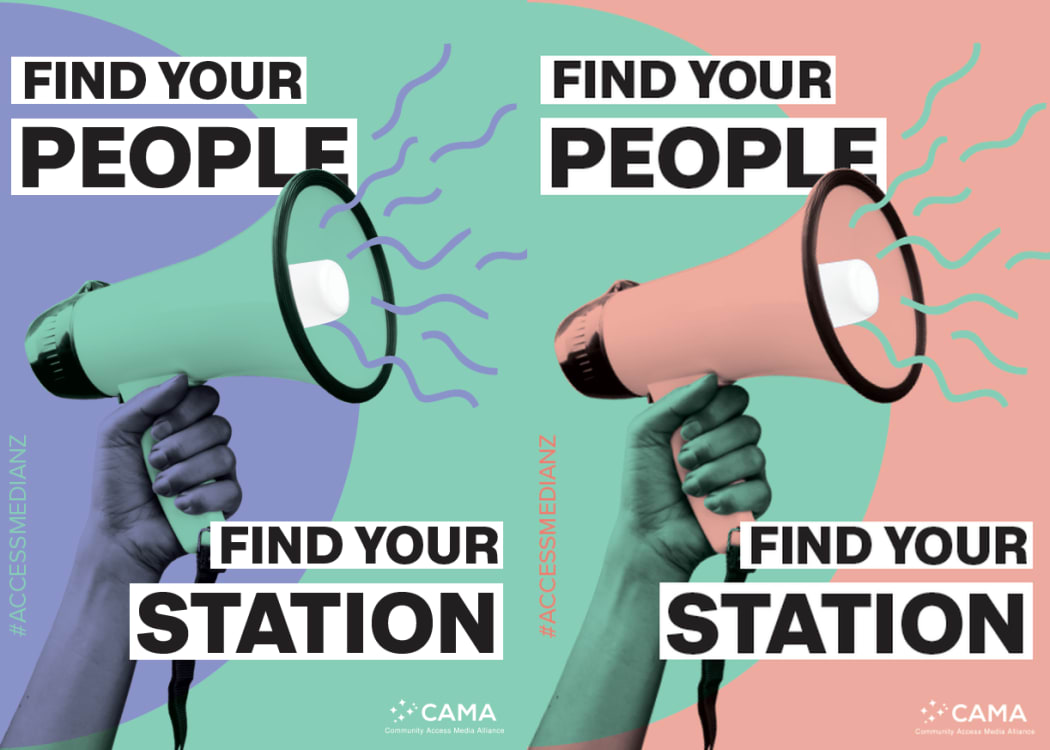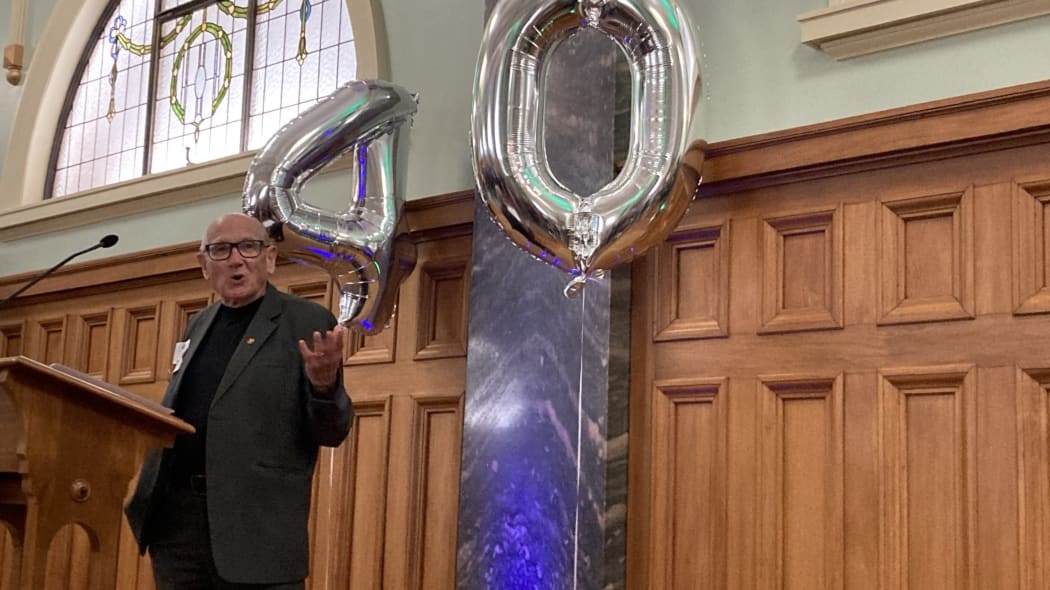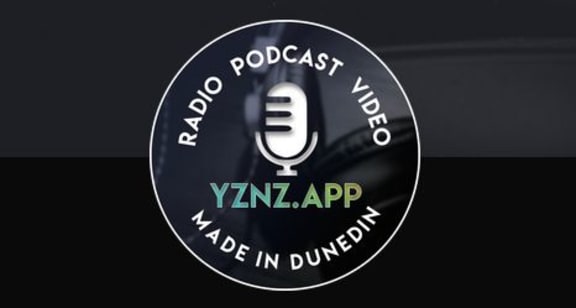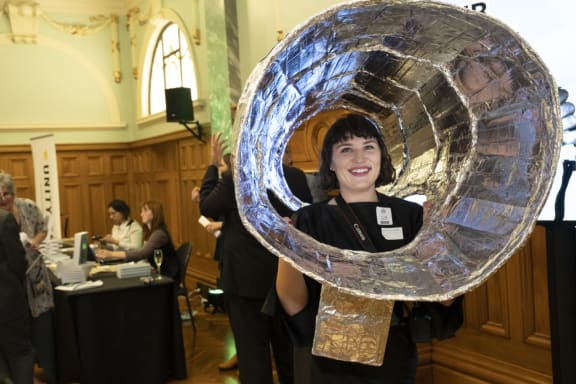The Access Radio movement is 40 years old and today 12 stations broadcast locally and online. Some fill local gaps left by stations hooked into national networks - and some produce programmes up for national awards. But low-budget broadcasting isn’t the only way to reach communities with content these days. Does access radio have a digital-age future?

Photo: supplied/ CAMA
Among the programmes in the running for ‘best documentary’ at the New Zealand Radio Awards next month is Widows of Shuhada.
It tells the stories of four Muslim women widowed by the Christchurch mosque attacks and what they found themselves facing afterwards.
The series is available from RNZ and was broadcast on RNZ National earlier this year -- but it was made by Plains FM, one of 12 community radio stations around the country.
It’s quite an endorsement for a programme presented by a student broadcaster - Asha Abde - and made by a mostly volunteer-run radio station.
It’s not the first time Plains FM has had national recognition.
The lead producer of Widows of Shuhada - Lana Hart - won a New Zealand Radio Award in 2015 for a series on Filipinos living and working in Canterbury. She also made a radio and podcast series - After March 15 - which ran for four months following the mosque shootings.
These are examples of what access radio stations can do locally - where they exist.
The network was founded 40 years ago as a movement to get otherwise unheard and unaired voices out on independently run local stations with limited public funding.
Today they are also available online - and so are the programmes, as podcasts
To reflect that, the network is now called the Community Access Media Alliance

Dr Brian Pauling - co-author of the book 'Sharing the Mic' at a reception at Parliament marking 40 years of access radio. Photo: photo / RNZ Mediawatch
Earlier this month, CAMA marked 40 years on air so far with a special function at Parliament, where the Minister of Broadcasting Kris Faafoi told the gathering his father had an access show in the 1980s, broadcasting in Tokelauan.
A new book telling the story of the movement’s first 40 years - Sharing the Mic by Dr Brian Pauling and Dr Brownyn Beatty - was released as well.
This week CAMA launched a new campaign urging people to ‘Find your Voice’ by finding your local access station.
But there’s no shortage of radio stations for listeners in most places. So what do the access stations do that others don't?
The network helps to fulfill the part of the Broadcasting Act 1989 which requires programmes are made by and for women, children, people living with disabilities, ethnic communities and people not traditionally given a voice in mainstream media.
“The Broadcasting Act explicitly outlines the need for platforms that serve a range of underserved communities. As long as the mainstream media is not serving them if there will still be a reason,” CAMA chair Jo Holsted told Mediawatch.
“It is relatively cheap to run a radio station. What we provide Is training and platforms and facilities. At the cost we run our stations at per year, you couldn’t argue that we’re not good bang- for-buck against any other kind of station,” said Holsted, who does Community Liaison for Auckland region access station Planet FM.

The Youth Zone app. Photo: screenshot
Dunedin-based Otago Access Radio airs shows made by local school kids and a daily after-school show Youth Zone. OAR launched an app for Youth Zone in 2019 where kids can also submit their own content
One of the most ambitious stations is Fresh FM, which broadcasts from four locations - Takaka, Motueka and Blenheim as well as its HQ in Nelson. That came in handy when fires ravaged the Nelson Hills and threatened the Fresh FM main studio in Founders Park two years ago.
In a review of the community access network in 2018, the AUT’s radio specialist Dr Matt Moolgaard said some staions were "the last truly ‘local’ media left in some regions."
“The pull-out of Fairfax titles from the regions, the networking of commercial radio and the lack of regional television means that Access Radio has developed a niche in local information services, Civil Defence broadcasting and localised arts and culture programming,” said Dr Mollgaard.
But his review also noted in 2018 that there had been no increase in funding for Access Radio in nearly a decade.

Photo: supplied
Since then the government has invested millions in ‘strengthening public media' and last year’s Budget said new funding should prioritise “under-served audiences.”
Access stations got a modest boost in the most recent NZ on Air funding round in April.
“For a long time I think we were regarded as a ‘nice to have’. After Covid, and prior to last year’s budget, we were invited to apply for more funding as individual stations. We hadn’t had any funding increase for the best part of ten years and that boost made a really big difference,” Holsted said.
The 12 stations get funding in four tiers - Planet FM serving greatest audience in greater Auckland gets just over $300,000 a year. The smallest ones - Arrow FM in Masterton and Coast Access in Kapiti get less than $200,000.
There’s also funding for a joint platform to make programmes and output available online.
But all this is all done for sums that are insignificant set against the budgets for the likes of RNZ or national TV programmes.
The future for Access Media

CAMA national co-ordinator Sasha Borissenko at the 40th anniversary celebration in Parliament. Photo: supplied / Lindsay Keats
The entire public media sector’s future is up in the air as the government pursues a new media entity - which could mean the Broadcasting Act would be rewritten.
These days people and communities around the country can easily connect on social media as well as locally via radio.
Do the 12 local radio stations around the country have a long-term future ?
“In the age of digital media and cost-cutting we’ve seen a decline in community-based print publications. I was at Fairfax Media when all those cuts happened and I think people are starting to realise that community-based content is needed more now than ever,” said Sasha Borissenko, national co-ordinator for CAMA.
“All the stations were running throughout Covid and it was an opportunity for the government to team up with them to get the messages across. How else do public service entities reach these audiences? You could go down the mainstream media route, but there is no guarantee. Refugee and migrant communities can be fairly isolated and this is an avenue for them,“ she said.
But the internet has given communities a cheap way to reach people which didn’t exist when Access Radio kicked off 40 years ago. It is also notoriously difficult to gauge the listenership of stations serving small audiences.
How do they know enough people are actually listening to Access stations?
“It’s not about audience numbers, clicks and money. In terms of the radio, we don’t measure that because the surveys cost a lot of money. We can measure audience numbers from our podcasting platform accessmedia.nz - and that’s been quite successful,” she said.
“The aim of the game is not to be popular but just to be known enough to reach these communities so they feel comfortable coming forward," she said.
Now that community broadcasting stations have run for the past 40 years, and the current stations in the network have all be running for more than ten, is it likely the network will expand?.
“We don’t have a presence in the Bay of Plenty nor do we have one in Northland; I think that needs to be explored,” Borrissenko said.
“We have an increasing population of baby boomers who love radio and like to listen to radio that reflects their ideas. It’s happening now in Kapiti where the local station reflects that population. If we are really serving our communities there’s a void out there,” she said.

